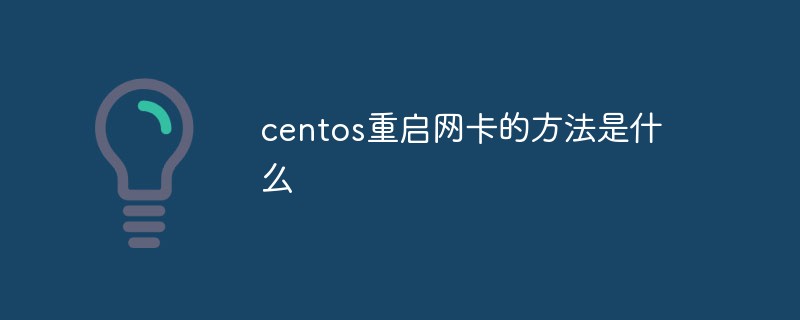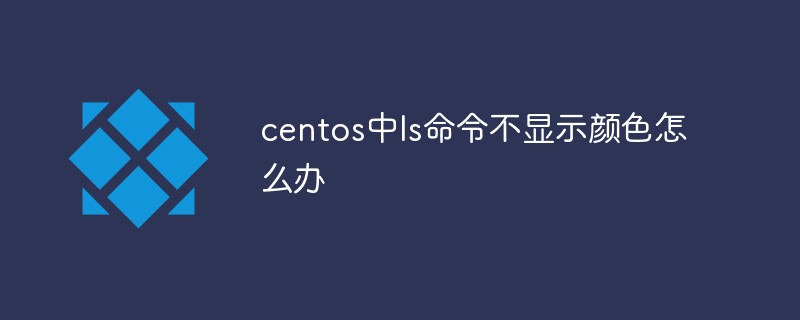How to install multiple php in centos: first introduce the EPEL library and REMI library for yum; then enable the PHP source "remi-php71" through the command "yum-config-manager --enable remi-php71"; then Just install and configure "php56".

Install multiple versions of php in centos and use it for nginx at the same time
Install php7 in the newly created virtual machine , after installing it, I found that some older projects could not run. Since the php7 version has been significantly modified compared to the php5 version, many functions were not abandoned, but removed, causing many problems. I had to install another php version. , what I want to install is php5.6, I searched on the Internet for PHP multi-version management in Linux, and recommended phpenv. I tried it all, but with no results, so I had to try another method until I found this article and solved it directly. Below Let me introduce the installation and configuration process.
Recommended: "centos Tutorial"
In this case, you can actually install it directly in a Linux system through yum and other tools For different PHP versions, register the PHP-FPM service separately and configure it in the server.
Experimental environment
CENTOS7
Nginx v1.12.2
PHP7 (set as the system default PHP version) and PHP5.6
Server IP 192.168.56.100
Install PHP7 and PHP5.6
First introduce two libraries for yum : EPEL and REMI, because these two libraries provide us with the latest PHP version source, the PHP version in the yum library that comes with CENTOS is too old.
# yum install https://dl.fedoraproject.org/pub/epel/epel-release-latest-7.noarch.rpm # yum install http://rpms.remirepo.net/enterprise/remi-release-7.rpm
Install php71
# yum-config-manager --enable remi-php71 [Default] # yum install php php-common php-fpm # yum install php-mysql php-pecl-memcache php-pecl-memcached php-gd php-mbstring php-mcrypt php-xml php-pecl-apc php-cli php-pear php-pdo
The first sentence is used to enable the PHP source remi-php71
Install php56
# yum install php56 php56-php-common php56-php-fpm # yum install php56-php-mysql php56-php-pecl-memcache php56-php-pecl-memcached php56-php-gd php56-php-mbstring php56-php-mcrypt php56-php-xml php56-php-pecl-apc php56-php-cli php56-php-pear php56-php-pdo
Execute php -v in linux and verify that the current php version should be 7.1
After installation, you need to configure php-fpm and php56-php-fpm. They are the Fastcgi process managers of PHP. In Linux, the web server calls PHP through them.
Okay, let’s start the configuration. .
The configuration files corresponding to the two php versions are
php-fpm (default 7.1) – /etc/php-fpm.d/www.conf php56-php-fpm – /opt/remi/php56/root/etc/php-fpm.d/www.conf
(It’s amazing, the directory where the php56 version is installed is in the opt directory)
Open the two configuration files , change the following code
listen = 127.0.0.1:9000[php-fpm] listen = 127.0.0.1:9001[php56-php-fpm]
If php-fpm is called through socket communication, change the code as follows
listen = /var/run/php-fpm/php-fpm.sock[php-fpm] listen = /opt/remi/php56/root/var/run/php-fpm/php-fpm.sock[php56-php-fpm]
Register and enable two versions of php-fpm service
# systemctl enable nginx # systemctl start nginx # systemctl enable mariadb # systemctl start mariadb ---------------- PHP 7.1 ---------------- # systemctl enable php-fpm # systemctl start php-fpm ---------------- PHP 5.6 ---------------- # systemctl enable php56-fpm # systemctl start php56-php-fpm
Use php7 nginx server configuration
server {
listen 80;
server_name example1.com www.example1.com;
root /var/www/html/example1.com/;
index index.php index.html index.htm;
#charset koi8-r;
access_log /var/log/nginx/example1.com/example1_access_log;
error_log /var/log/nginx/example1.com/example1_error_log error;
location / {
try_files $uri $uri/ /index.php?$query_string;
}
# pass the PHP scripts to FastCGI server listening on 127.0.0.1:9000
location ~ \.php$ {
root /var/www/html/example1.com/;
fastcgi_pass 127.0.0.1:9000;#set port for php-fpm to listen on
fastcgi_index index.php;
fastcgi_param SCRIPT_FILENAME $document_root$fastcgi_script_name;
include fastcgi_params;
include /etc/nginx/fastcgi_params;
}
}
`Use php56 nginx server configuration
server {
listen 80;
server_name example2.com www.example2.com;
root /var/www/html/example2.com/;
index index.php index.html index.htm;
#charset koi8-r;
access_log /var/log/nginx/example2.com/example2_access_log;
error_log /var/log/nginx/example2.com/example2_error_log error;
location / {
try_files $uri $uri/ /index.php?$query_string;
}
# pass the PHP scripts to FastCGI server listening on 127.0.0.1:9000
location ~ \.php$ {
root /var/www/html/example2.com/;
fastcgi_pass 127.0.0.1:9001;#set port for php56-php-fpm to listen on
fastcgi_index index.php;
fastcgi_param SCRIPT_FILENAME $document_root$fastcgi_script_name;
include fastcgi_params;
include /etc/nginx/fastcgi_params;
}
}Add test web page file
# echo "<?php phpinfo(); ?>" > /var/www/html/example1.com/info.php # echo "<?php phpinfo(); ?>" > /var/www/html/example2.com/info.php
After testing
Visit example1.com/info.php and example2.com/info.php to test.
If you configure it in a local virtual machine, don’t forget to add
192.168.56.100 example1.com example1 192.168.56.100 example2.com example2to the local host file
The above is the detailed content of How to install multiple php on centos. For more information, please follow other related articles on the PHP Chinese website!
 centos用什么命令可查版本号Mar 03, 2022 pm 06:10 PM
centos用什么命令可查版本号Mar 03, 2022 pm 06:10 PM查版本号的命令:1、“cat /etc/issue”或“cat /etc/redhat-release”,可输出centos版本号;2、“cat /proc/version”、“uname -a”或“uname -r”,可输出内核版本号。
 centos重启网卡的方法是什么Feb 22, 2023 pm 04:00 PM
centos重启网卡的方法是什么Feb 22, 2023 pm 04:00 PMcentos重启网卡的方法:1、对于centos6的网卡重启命令是“service network restart”;2、对于centos7的网卡重启命令是“systemctl restart network”。
 centos php怎么安装opcacheJan 19, 2023 am 09:50 AM
centos php怎么安装opcacheJan 19, 2023 am 09:50 AMcentos php安装opcache的方法:1、执行“yum list php73* | grep opcache”命令;2、通过“yum install php73-php-opcache.x86_64”安装opcache;3、使用“find / -name opcache.so”查找“opcache.so”的位置并将其移动到php的扩展目录即可。
 centos 怎么离线安装 mysqlFeb 15, 2023 am 09:56 AM
centos 怎么离线安装 mysqlFeb 15, 2023 am 09:56 AMcentos离线安装mysql的方法:1、将lib中的所有依赖上传到linux中,并用yum命令进行安装;2、解压MySQL并把文件复制到想要安装的目录;3、修改my.cnf配置文件;4、复制启动脚本到资源目录并修改启动脚本;5、将mysqld服务加入到系统服务里面;6、将mysql客户端配置到环境变量中,并使配置生效即可。
 centos 7安装不出现界面怎么办Jan 03, 2023 pm 05:33 PM
centos 7安装不出现界面怎么办Jan 03, 2023 pm 05:33 PMcentos7安装不出现界面的解决办法:1、选择“Install CentOS 7”,按“e”进入启动引导界面;2、 将“inst.stage2=hd:LABEL=CentOS\x207\x20x86_64”改为“linux dd”;3、重新进入“Install CentOS 7”,按“e”将“hd:”后的字符替换成“/dev/sdd4”,然后按“Ctrl+x”执行即可。
 centos 怎么删除 phpFeb 24, 2021 am 09:15 AM
centos 怎么删除 phpFeb 24, 2021 am 09:15 AMcentos删除php的方法:1、通过“#rpm -qa|grep php”命令查看全部php软件包;2、通过“rpm -e”命令卸载相应的依赖项;3、重新使用“php -v”命令查看版本信息即可。
 如何在 CentOS 9 Stream 上安装 NagiosMay 10, 2023 pm 07:58 PM
如何在 CentOS 9 Stream 上安装 NagiosMay 10, 2023 pm 07:58 PM我们的PC中有一个磁盘驱动器专门用于所有与Windows操作系统相关的安装。该驱动器通常是C驱动器。如果您还在PC的C盘上安装了最新的Windows11操作系统,那么所有系统更新(很可能是您安装的所有软件)都会将其所有文件存储在C盘中。因此,保持此驱动器没有垃圾文件并在C驱动器中拥有足够的存储空间变得非常重要,因为该驱动器拥有的空间越多,您的Windows11操作系统运行起来就越顺畅。但是您可以在磁盘驱动器上增加多少空间以及可以删除多少文件是有限制的。在这种情况下,
 centos中ls命令不显示颜色怎么办Apr 20, 2022 pm 03:16 PM
centos中ls命令不显示颜色怎么办Apr 20, 2022 pm 03:16 PM方法:1、利用“vim ~/.bashrc”编辑用户目录(~)下的“.bashrc”文件;2、在文件内添加“alias ls="ls --color"”;3、利用“:wq!”命令保存文件内的更改;4、“exit”命令退出终端后重新连接即可。


Hot AI Tools

Undresser.AI Undress
AI-powered app for creating realistic nude photos

AI Clothes Remover
Online AI tool for removing clothes from photos.

Undress AI Tool
Undress images for free

Clothoff.io
AI clothes remover

AI Hentai Generator
Generate AI Hentai for free.

Hot Article

Hot Tools

SublimeText3 Chinese version
Chinese version, very easy to use

SublimeText3 Mac version
God-level code editing software (SublimeText3)

MantisBT
Mantis is an easy-to-deploy web-based defect tracking tool designed to aid in product defect tracking. It requires PHP, MySQL and a web server. Check out our demo and hosting services.

Dreamweaver CS6
Visual web development tools

DVWA
Damn Vulnerable Web App (DVWA) is a PHP/MySQL web application that is very vulnerable. Its main goals are to be an aid for security professionals to test their skills and tools in a legal environment, to help web developers better understand the process of securing web applications, and to help teachers/students teach/learn in a classroom environment Web application security. The goal of DVWA is to practice some of the most common web vulnerabilities through a simple and straightforward interface, with varying degrees of difficulty. Please note that this software






